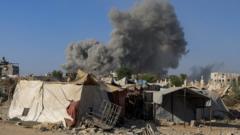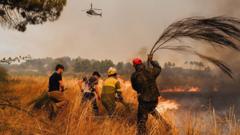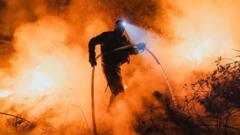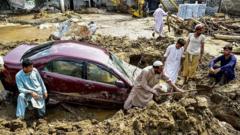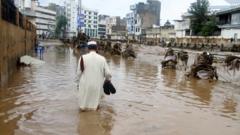The WHO's recent report highlights the urgent need for protective measures against heat stress, especially in construction and agriculture sectors.
**WHO Raises Alarm Over Extreme Heat Risks for Workers**
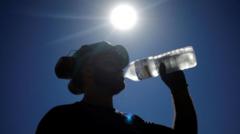
**WHO Raises Alarm Over Extreme Heat Risks for Workers**
Global health organizations urge immediate action to protect workers as heatwaves become more common.
The World Health Organization (WHO) has issued a critical report addressing the growing risks of extreme heat for workers globally, particularly as climate change leads to more frequent and severe heatwaves. This pressing issue demands collaborative efforts from governments, employers, and employees to establish effective adaptation strategies. With millions already affected by heat stress, the report emphasizes that these environmental challenges pose significant risks not only to health but also to productivity.
This marks the first official WHO report focusing on heat stress at work since 1969, signaling the urgency of the situation according to Rüdiger Krech, WHO's director for environment, climate, and health. He highlighted the real health hazards associated with prolonged exposure to elevated temperatures, such as strokes, kidney failure, and dehydration. Data indicates that the last decade has seen unprecedented high temperatures, with projections for 2024 to be the hottest on record.
The current climate crisis has led to average temperatures reaching alarming levels, especially in regions like Europe, where temperatures frequently surpass 40 degrees Celsius (104F) and can soar to 50C in parts of Africa and the Middle East. The report suggests a direct correlation between temperature rise and decreased productivity, estimating a 2% drop for every degree above 20C. Additionally, incidents of workplace accidents increase significantly during heatwaves—an observed 7% rise during the 2023 European heatwave.
Countries like Italy and various Swiss cantons are already responding by implementing protective measures for outdoor workers, such as pausing construction during extreme heat. The Italian government recently enacted a protocol to safeguard workers from the utmost heat, signaling a proactive approach towards tackling this pressing issue. Swiss trade unions are advocating for similar measures, emphasizing the need for construction firms to acknowledge the dangers of working in extreme temperatures.
While the focus is on workplace adjustments, the WHO report also underscores that vulnerable populations, particularly the elderly and children, face heightened risks during heatwaves. In countries like Germany, schools have provisions for declaring "Hitzefrei," or heat-free days, although recent trends have seen a reluctance to disrupt the educational process. The ongoing impact of COVID-19 on education is evident, and there are calls for better school infrastructure, including improved ventilation and air conditioning systems, to ensure environments conducive to learning.
Krech stresses the importance of involving all stakeholders—governments, employers, and local health authorities—in discussions surrounding adaptation strategies. He highlights the need for thoughtful consideration regarding school and work clothes suitable for high temperatures, particularly in the context of budgeting constraints.
Ultimately, the financial implications of failing to adapt workplaces to cope with extreme heat may be severe, with Krech urging decision-makers to recognize the potential losses in productivity from health-related issues linked to climate change. The urgency to act now for better working and learning environments cannot be overstated, as inaction could lead to dire consequences in the future.
This marks the first official WHO report focusing on heat stress at work since 1969, signaling the urgency of the situation according to Rüdiger Krech, WHO's director for environment, climate, and health. He highlighted the real health hazards associated with prolonged exposure to elevated temperatures, such as strokes, kidney failure, and dehydration. Data indicates that the last decade has seen unprecedented high temperatures, with projections for 2024 to be the hottest on record.
The current climate crisis has led to average temperatures reaching alarming levels, especially in regions like Europe, where temperatures frequently surpass 40 degrees Celsius (104F) and can soar to 50C in parts of Africa and the Middle East. The report suggests a direct correlation between temperature rise and decreased productivity, estimating a 2% drop for every degree above 20C. Additionally, incidents of workplace accidents increase significantly during heatwaves—an observed 7% rise during the 2023 European heatwave.
Countries like Italy and various Swiss cantons are already responding by implementing protective measures for outdoor workers, such as pausing construction during extreme heat. The Italian government recently enacted a protocol to safeguard workers from the utmost heat, signaling a proactive approach towards tackling this pressing issue. Swiss trade unions are advocating for similar measures, emphasizing the need for construction firms to acknowledge the dangers of working in extreme temperatures.
While the focus is on workplace adjustments, the WHO report also underscores that vulnerable populations, particularly the elderly and children, face heightened risks during heatwaves. In countries like Germany, schools have provisions for declaring "Hitzefrei," or heat-free days, although recent trends have seen a reluctance to disrupt the educational process. The ongoing impact of COVID-19 on education is evident, and there are calls for better school infrastructure, including improved ventilation and air conditioning systems, to ensure environments conducive to learning.
Krech stresses the importance of involving all stakeholders—governments, employers, and local health authorities—in discussions surrounding adaptation strategies. He highlights the need for thoughtful consideration regarding school and work clothes suitable for high temperatures, particularly in the context of budgeting constraints.
Ultimately, the financial implications of failing to adapt workplaces to cope with extreme heat may be severe, with Krech urging decision-makers to recognize the potential losses in productivity from health-related issues linked to climate change. The urgency to act now for better working and learning environments cannot be overstated, as inaction could lead to dire consequences in the future.



